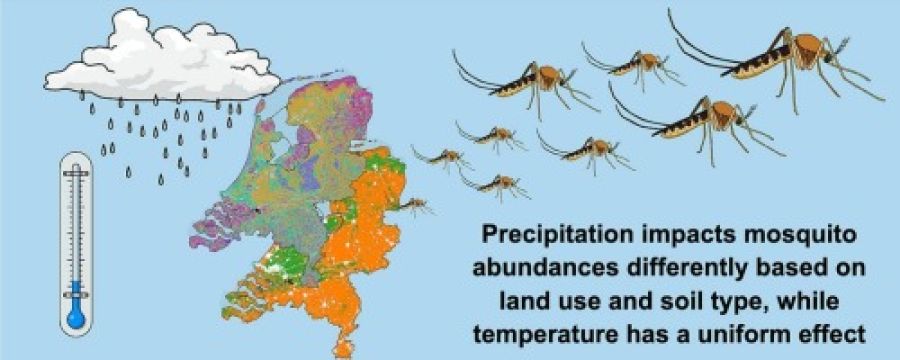Interactive effects of climate, land use and soil type on Culex pipiens/torrentium abundance

This publication is part of the project ‘Preparing for vector-borne virus outbreaks in a changing world: a One Health Approach’ (NWA.1160.1S.210) which is (partly) financed by the Dutch Research Council (NWO).

Authors: Louie Krol, Rody Blom, Martha Dellar, Jordy G. van der Beek, Arjan C.J. Stroo, Peter M. van Bodegom, Gertjan W. Geerling, Constantianus J.M. Koenraad, Maarten Schrama.
The incidence and risk of mosquito-borne disease outbreaks in Northwestern Europe has increased over the last few decades. Understanding the underlying environmental drivers of mosquito population dynamics helps to adequately assess mosquito-borne disease risk. While previous studies have focussed primarily on the effects of climatic conditions (i.e., temperature and precipitation) and/or local environmental conditions individually, it remains unclear how climatic conditions interact with local environmental factors such as land use and soil type, and how these subsequently affect mosquito abundance.
Here, we set out to study the interactive effects of land use, soil type and climatic conditions on the abundance of Culex pipiens/torrentium, highly abundant vectors of West Nile virus and Usutu virus. Mosquitoes were sampled at 14 sites throughout the Netherlands. At each site, weekly mosquito collections were carried out between early July and mid-October 2020 and 2021. To assess the effect of the aforementioned environmental factors, we performed a series of generalized linear mixed models and non-parametric statistical tests.
Our results show that mosquito abundance and species richness consistently differ among land use- and soil types, with peri-urban areas with peat/clay soils having the highest Cx. pipiens/torrentium abundance and sandy rural areas having the lowest. Furthermore, we observed differences in precipitation-mediated effects on Cx. pipiens/torrentium abundance between (peri-)urban and other land uses and soil types. In contrast, effects of temperature on Cx. pipiens/torrentium abundance remain similar between different land use and soil types.
Our study highlights the importance of both land use and soil type in conjunction with climatic conditions for understanding mosquito abundances. Particularly in relation to rainfall events, land use and soil type has a marked effect on mosquito abundance. These findings underscore the importance of local environmental parameters for studies focusing on predicting or mitigating disease risk.
Source: ScienceDirect
Date: July 6, 2023